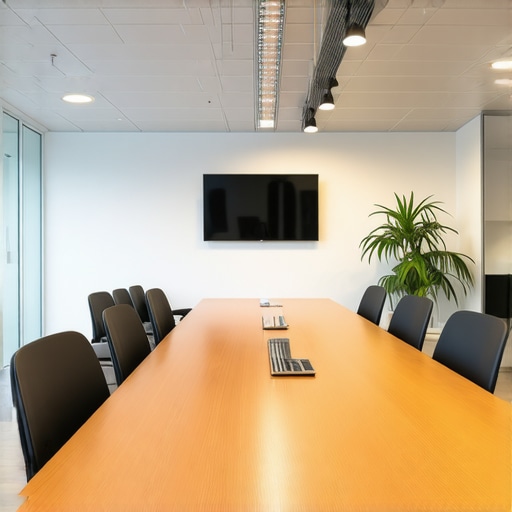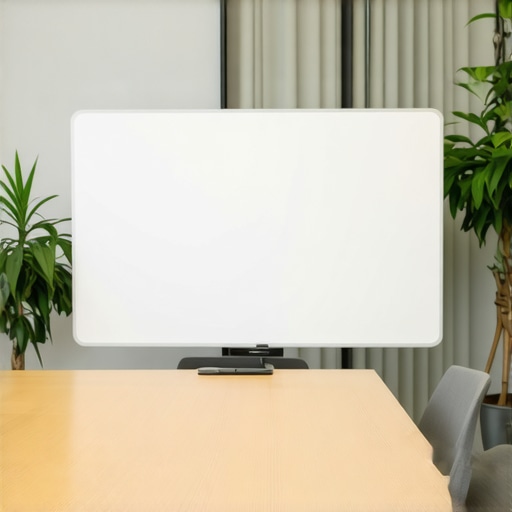My Personal Journey into the Heart of Startup Collaboration Spaces
It all began last year when I was searching for the perfect place to brainstorm with my team. I remember walking into a vibrant coworking space, feeling the buzz of innovation and the promise of new ideas. That experience sparked my fascination with how the right meeting rooms can catalyze startup growth in 2024.
What Makes a Meeting Room Truly Power Up Your Startup?
From my perspective, the best conference rooms are more than just four walls and a table—they’re environments designed to inspire, foster collaboration, and streamline productivity. I’ve found that having access to modern amenities, flexible layouts, and a creative atmosphere significantly impacts the effectiveness of my meetings. For instance, some spaces offer advanced audiovisual tools that make virtual collaborations seamless, a feature I discovered while reading top coworking spaces for startup success.
The Hidden Power of Location and Community
In my experience, location plays a pivotal role. Being situated in a thriving startup hub, like Silicon Valley or emerging ecosystems, provides networking opportunities that can accelerate growth. I also value spaces that foster a sense of community—shared ideas, mentorship, and spontaneous conversations often spark the next big breakthrough. For example, I recently explored flexible conference spaces designed specifically for startups eager to scale.
Why Do I Rely on Top-rated Meeting Room Solutions?
As a startup founder, I’ve learned that choosing the right conference room solutions isn’t just about aesthetics but about functionality. According to industry insights, effective conference rooms can boost productivity and innovation—crucial for early-stage companies aiming to stand out. I’ve personally benefited from spaces that incorporate ergonomic furniture, high-speed Wi-Fi, and soundproofing, which you can explore more at effective meeting spaces.
How Can I Make the Most Out of My Conference Room Experience?
To truly capitalize on these spaces, I recommend preparing an agenda in advance, utilizing the available tech tools, and encouraging open dialogue. A well-structured meeting in a thoughtfully designed room can lead to breakthrough ideas, stronger team alignment, and faster decision-making. I invite you to share your favorite meeting environments or tips in the comments below!
For more tips on selecting the perfect space, check out startup success secrets.
Unlocking the Full Potential of Your Startup’s Meeting Spaces
As startups evolve, the importance of strategically selecting and utilizing meeting rooms becomes even more critical. Modern spaces equipped with cutting-edge technology and flexible layouts can transform routine meetings into catalysts for innovation. For example, some coworking spaces now incorporate modular furniture, allowing teams to reconfigure rooms based on session goals—whether brainstorming, client presentations, or deep-focus work. To explore how to make the most of these environments, check out effective conference spaces for startups.
How Do Advanced Technologies Elevate Startup Meetings?
Integrating advanced audiovisual equipment, smart whiteboards, and seamless connectivity can significantly enhance collaboration. High-quality video conferencing tools ensure remote team members feel engaged, fostering inclusivity and diverse ideas. Moreover, interactive whiteboards in coworking spaces facilitate real-time brainstorming, helping teams visualize concepts instantly. According to industry research from top coworking spaces for startup growth, these tech features are no longer optional—they are essential for competitive startups in 2024.

What Are the Nuances of Choosing the Right Location for Your Startup Meetings?
Location remains a cornerstone of effective startup collaboration. Proximity to industry hubs, amenities, and transportation links can facilitate spontaneous networking and idea exchange. For instance, spaces near innovation districts or university campuses tend to foster serendipitous interactions. Additionally, choosing a space within a community-oriented environment encourages mentorship and partnership opportunities, accelerating growth. For strategic insights, consider reading top conference room solutions.
How Can Startups Tailor Meeting Environments to Drive Creativity and Productivity?
Customization is key. Startups should look for spaces that offer adaptable layouts, private zones for sensitive discussions, and communal areas to promote cross-team engagement. Incorporating elements like inspiring decor, natural light, and ergonomic furniture can boost morale and focus. Furthermore, establishing a culture of preparation and openness during meetings maximizes the value derived from these environments. For practical tips on optimizing your meeting strategy, visit flexible conference spaces.
Are There Hidden Challenges in Leveraging Meeting Rooms for Startup Growth?
Absolutely. One common challenge is over-reliance on technology, which can backfire if systems fail during critical sessions. Additionally, noise and distractions in open coworking environments can hamper focus unless spaces are well-designed with soundproofing. Balancing privacy with accessibility also requires thoughtful planning—ensuring teams can have confidential discussions without sacrificing the collaborative energy of the space. Staying aware of these nuances allows startups to navigate potential pitfalls and truly harness the power of their meeting environments. For further reading on creating effective meeting strategies, see effective conference room strategies.
Beyond the Basics: Personal Reflections on Crafting the Ideal Startup Meeting Environment
Over the years, I’ve come to realize that the true power of a meeting room lies not just in its physical attributes but in its ability to adapt to the nuanced needs of a startup’s evolving journey. I recall a particular session in a space with panoramic natural light and modular furniture—an environment that seemed to breathe creativity into every discussion. It made me ponder: how do we, as entrepreneurs, fine-tune our spaces to foster continuous innovation?
The Subtle Art of Space Customization for Startups
In my experience, customizing a meeting environment goes beyond choosing trendy decor. It involves understanding the psychological and collaborative dynamics of your team. For example, I experimented with different seating arrangements—circle for open dialogue, clusters for project-specific talks, and private zones for sensitive negotiations. This flexibility, supported by spaces like flexible conference spaces, has proven invaluable in my journey. The key is to create a sanctuary that evolves with your projects, not just a static room.
How Do I Navigate the Tech-Driven Complexity of Modern Meeting Rooms?
Technology is a double-edged sword. When it works seamlessly, it amplifies productivity; when it fails, it hampers momentum. My personal strategy has been to prioritize redundancy—having backup plans for Wi-Fi, power, and AV equipment. I also make it a point to familiarize myself and my team with the tech features beforehand, much like rehearsing a presentation. Industry insights from top coworking spaces for startup success emphasize that tech integration isn’t optional anymore—it’s essential for competitive agility.
What Are the Hidden Layers of Location Strategy in Startup Success?
Location, often underestimated, can be a game-changer. I’ve learned that proximity to innovation hubs and a vibrant community can catalyze spontaneous collaborations. Yet, equally important is the emotional and cultural resonance of the space—does it inspire your team? Does it foster a sense of belonging? I found that spaces near universities or creative districts often spark serendipitous encounters, which I believe are the true catalysts for breakthrough ideas. For a deeper dive, check out top conference room solutions.
Can Personalization Truly Maximize Meeting Efficacy?
Absolutely. Personalization isn’t just about aesthetics; it’s about creating an environment where your team feels empowered to express ideas freely. I’ve seen startups incorporate elements like inspiring artwork, adjustable lighting, and even aromatherapy to boost morale and focus. In my own practice, I reserve certain rooms for deep work, equipped with noise-canceling features, while others are designed for energetic brainstorming sessions. This tailored approach, supported by flexible conference spaces, has been instrumental in maintaining high levels of engagement and innovation.
What Are the Overlooked Challenges in Leveraging Meeting Rooms for Growth?
One challenge I’ve faced is balancing openness with confidentiality. Open coworking environments foster collaboration but can sometimes compromise sensitive discussions. My solution has been to designate specific zones with soundproofing for confidential talks, a feature I highly recommend exploring at effective conference room strategies. Additionally, over-reliance on technology can be risky—regular maintenance and backup plans are non-negotiable. Recognizing these nuances has helped me turn potential pitfalls into opportunities for refining our meeting strategies, ultimately fueling sustained growth and innovation.
Integrating Smart Technologies for Seamless Collaboration
As I delve deeper into the intricacies of effective startup environments, I realize that integrating smart technologies is no longer optional but essential for maintaining a competitive edge. Advanced audiovisual systems, AI-powered whiteboards, and IoT devices can transform mundane meetings into dynamic innovation sessions. For example, smart whiteboards that automatically save and organize brainstorming outputs can streamline follow-up actions, significantly boosting productivity. Industry leader top coworking spaces for startup growth are already adopting these innovations, setting new standards for collaborative excellence.
Designing for Psychological Impact and Cognitive Flow
Beyond functionality, the psychological design of a meeting space profoundly influences creativity and decision-making. From my experience, incorporating elements like biophilic design—natural materials, greenery, and daylight—can reduce stress and enhance cognitive function. I recall a particular workspace featuring panoramic windows and living walls, which seemed to energize and focus my team. Such environments foster a sense of well-being, essential for sustained innovation. To explore how to craft such inspiring spaces, visit creative coworking spaces.

Strategic Location Planning for Serendipitous Innovation
My experience underscores that location is more than a logistical consideration—it’s a catalyst for serendipitous encounters and spontaneous collaborations. Spaces situated near universities, tech hubs, or cultural districts tend to foster cross-pollination of ideas. Moreover, I’ve found that integrating these locations with strategic transportation links ensures accessibility, encouraging diverse participation. For startups aiming to maximize innovation, selecting a space that resonates culturally and emotionally can be transformative. For in-depth insights, I recommend exploring maximize startup productivity through location.
Mastering the Art of Adaptive Space Personalization
Personalization is a nuanced art that can significantly elevate meeting efficacy. I’ve experimented with adjustable lighting, acoustic zones, and even scent diffusers to create tailored environments. For instance, quieter, dimly lit rooms foster deep focus, while vibrant, well-lit spaces energize brainstorming sessions. The key lies in understanding your team’s dynamic needs and designing flexible layouts that can adapt accordingly. Spaces that support this level of customization, like those detailed in flexible conference spaces, are invaluable assets for sustained innovation.
Overcoming the Hidden Challenges of Tech Dependence
While advanced technology can be a game-changer, it also introduces vulnerabilities. I have learned the importance of redundancy—having backup power supplies, offline modes, and manual processes. During a crucial pitch, a Wi-Fi outage nearly derailed our presentation, but pre-downloaded materials saved the day. This experience drove home that meticulous planning and familiarity with your tech arsenal are vital. Industry research from effective conference spaces highlights that resilience is the backbone of technological integration.
Things I Wish I Knew Earlier (or You Might Find Surprising)
The Power of Environment
Looking back, I realize that choosing the right meeting space can make or break a session. I once tried to squeeze a brainstorming into a noisy, open coworking area, only to realize later that a quiet, well-equipped conference room would have sparked more creativity. The environment truly influences our ability to think clearly and collaborate effectively.
Technology as a Double-Edged Sword
Initially, I was excited about all the advanced tech—smart whiteboards, seamless video calls, IoT devices. But I learned the hard way that tech failures can derail a meeting. Now, I always prepare backup plans and ensure everyone is familiar with the tools beforehand, which saves time and keeps the momentum going.
Location Matters More Than I Thought
Proximity to innovation hubs or vibrant communities can open unexpected doors. I found that spaces near universities or tech districts often lead to spontaneous conversations with potential partners or mentors, fueling growth in ways I didn’t anticipate.
Personalization Enhances Engagement
Creating a space tailored to your team’s needs—adjustable lighting, private zones, inspiring decor—can boost morale and focus. I experimented with different setups and noticed a significant difference in productivity and enthusiasm.
Balancing Openness and Confidentiality
Open coworking environments foster collaboration, but privacy is essential for sensitive discussions. I now designate specific soundproof zones for confidential talks, ensuring trust and focus go hand in hand.
Resources I’ve Come to Trust Over Time- Coworking Central: Their insights on innovative meeting spaces have guided many of my decisions and helped me understand what makes a space truly effective.
- Forbes Innovation Section: Offers valuable articles on how technology transforms collaboration environments, which I found very insightful.
- Harvard Business Review: Their research on organizational behavior and space design has deepened my appreciation for the psychological impact of environment on productivity.
Parting Thoughts from My Perspective
As someone who has navigated the startup landscape, I believe that the right meeting room environment is a hidden catalyst for growth. It’s not just about fancy furniture or high-tech gadgets, but about creating a space that adapts to your evolving needs, fosters genuine collaboration, and inspires innovation. If this resonates with you, I’d love to hear your own experiences or tips—feel free to share below or reach out through our contact page. Here’s to finding and crafting the perfect space for your startup’s journey!
